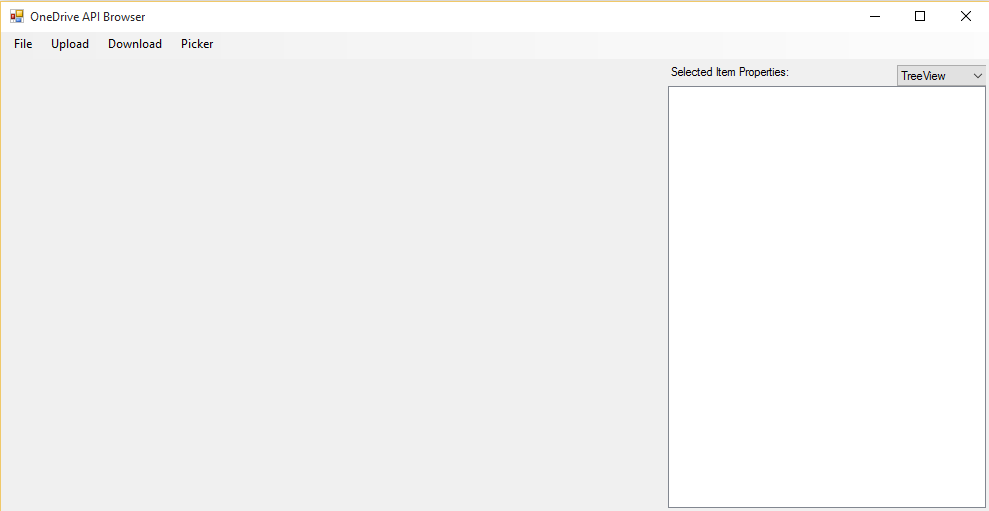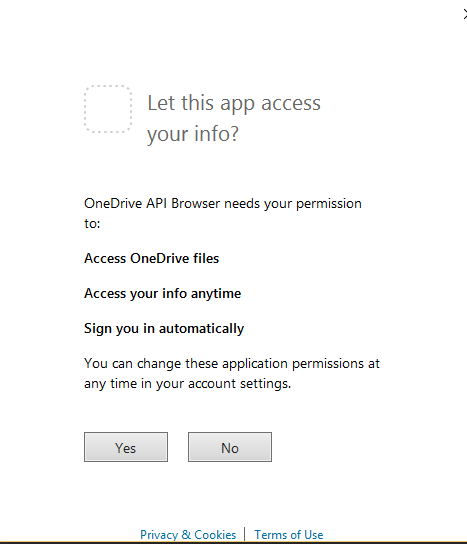| page_type | products | languages | extensions | |||||||||||||
|---|---|---|---|---|---|---|---|---|---|---|---|---|---|---|---|---|
sample |
|
|
|
The OneDriveAPIBrowser sample is a Windows Forms app sample that uses the Microsoft Graph .NET Client Library for C#/.NET. In this sample, users can browse files and folders that are stored on OneDrive, and view metadata.
- Sign into the App Registration Portal using either your personal or work or school account.
- Select Add an app.
- Enter a name for the app, and select Create application. The registration page displays, listing the properties of your app.
- Under Platforms, select Add platform.
- Select Mobile application.
- Copy the Client Id (App Id) value to the clipboard. You'll need to use it in the sample app. The app id is a unique identifier for your app.
- Select Save.
- Install Visual Studio and all available updates, if you don't already have it.
- Download the OneDriveAPIBrowser sample from GitHub or create your own fork of the repository.
- From Visual Studio, open the OneDriveApiBrowser.sln solution.
- Go to the OneDriveApiBrowser project in the solution and view the code for FormBrowser.cs.
- Configure the sample to use the Client Id (App Id) that you registered by making it the value of the
MsaClientIdvariable:
private const string MsaClientId = "Insert your client ID here";In Visual Studio, select the sample OneDriveAPIBrowser from the Startup project list, and then press F5 or click Start to run the sample. The sample looks like this:
When the OneDrive API Browser app opens, choose File | Sign in... to sign in to a personal OneDrive account or to a business OneDrive account. Once you have signed in to your Microsoft account, a dialog will appear, asking for permissions to access OneDrive files.
Click Yes.
Your OneDrive items will appear on the left pane, with each item represented by a thumbnail. On the right pane, the selected item's properties are displayed. You can choose how the item properties are displayed, whether its JSON or Tree View.
To upload a file, choose Upload from the menu and then choose Simple - Path-based to upload by path, or Simple - ID-based to upload by item id.
To download a file, select a file, and then choose Download from the menu.
This sample gets a Microsoft Graph GraphServiceClient instance and signs in the user using the GetAuthenticatedClient method in the AuthenticationHelper.cs file.
public static string[] Scopes = { "Files.ReadWrite.All" };
...
public static GraphServiceClient GetAuthenticatedClient()
{
if (graphClient == null)
{
// Create Microsoft Graph client.
try
{
graphClient = new GraphServiceClient(
"https://graph.microsoft.com/v1.0",
new DelegateAuthenticationProvider(
async (requestMessage) =>
{
var token = await GetTokenForUserAsync();
requestMessage.Headers.Authorization = new AuthenticationHeaderValue("bearer", token);
// This header has been added to identify our sample in the Microsoft Graph service. If extracting this code for your project please remove.
requestMessage.Headers.Add("SampleID", "uwp-csharp-apibrowser-sample");
}));
return graphClient;
}
catch (Exception ex)
{
Debug.WriteLine("Could not create a graph client: " + ex.Message);
}
}
return graphClient;
}
...The AuthenticationHelper.cs file also provides a SignOutAsync method to easily sign the user out:
public static void SignOut()
{
foreach (var user in IdentityClientApp.Users)
{
user.SignOut();
}
graphClient = null;
TokenForUser = null;
}This sample demonstrates how to get an item's properties, by calling the GetAsync method of the GraphServiceClient object:
folder = await this.graphClient.Drive.Root.Request().Expand(expandValue).GetAsync();This sample makes use of Microsoft Graph's ability to upload items by path or by id. Here, you upload an item by path:
// Since the ItemWithPath method is available only at Drive.Root, we need to strip
// /drive/root: (12 characters) from the parent path string.
string folderPath = targetFolder.ParentReference == null
? ""
: targetFolder.ParentReference.Path.Remove(0, 12) + "/" + Uri.EscapeUriString(targetFolder.Name);
var uploadPath = folderPath + "/" + Uri.EscapeUriString(System.IO.Path.GetFileName(filename));
// Use the Microsoft Graph SDK to upload the item by path.
var uploadedItem =
await
this.graphClient.Drive.Root.ItemWithPath(uploadPath).Content.Request().PutAsync<DriveItem>(stream); This example shows how to upload an item by id:
var uploadedItem =
await
this.graphClient.Drive.Items[targetFolder.Id].ItemWithPath(filename).Content.Request()
.PutAsync<DriveItem>(stream); You can continue to explore this sample and the rest of its features by using GitHub or Visual Studio. To view a Windows Universal app sample that uses the Microsoft Graph SDK for CSharp/.NET, see OneDrivePhotoBrowser. Make sure to also check out the Microsoft Graph API's official documentation at https://developer.microsoft.com/en-us/graph/.
This project has adopted the Microsoft Open Source Code of Conduct. For more information see the Code of Conduct FAQ or contact opencode@microsoft.com with any additional questions or comments.

